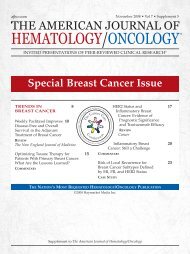Understanding palliative care - Haymarket Media Group
Understanding palliative care - Haymarket Media Group
Understanding palliative care - Haymarket Media Group
Create successful ePaper yourself
Turn your PDF publications into a flip-book with our unique Google optimized e-Paper software.
Ever<strong>care</strong><br />
5<br />
1Palliative <strong>care</strong> is appropriate at any point in an<br />
illness and can be administered in conjunction<br />
with curative treatments. The goal of <strong>palliative</strong><br />
<strong>care</strong> is to anticipate, prevent and relieve suffering and<br />
symptoms — regardless of the stage of a disease — and<br />
optimize a patient’s quality of life. Palliative <strong>care</strong> is not<br />
restricted to end-of-life <strong>care</strong> and often is provided<br />
alongside curative and disease-modifying treatments.<br />
It is generally high-touch and low-tech, focusing on the<br />
right <strong>care</strong> for the right patient at the right time.<br />
2Pain management is often inadequate in individuals<br />
who could benefit from it the most.<br />
Although pain is highly prevalent in patients<br />
with advanced illness, undertreatment is common.<br />
According to the Journal of Pain and Symptom Management,<br />
undertreatment of pain in those with advanced<br />
disease is a far more pressing concern than the risk of<br />
hastened death.* Palliative <strong>care</strong> includes very aggressive,<br />
individualized measures to control a patient’s pain<br />
and other distressing symptoms.<br />
3Palliative <strong>care</strong> is not a one-size-fits-all<br />
approach. Palliative <strong>care</strong> addresses the continuum<br />
of physical, social and spiritual needs and<br />
facilitates patient autonomy, access to information and<br />
personal choice. It is highly customized, with the<br />
utmost respect for a patient’s values, culture, wishes<br />
and dignity. Palliative <strong>care</strong> also reaches out to family<br />
members and loved ones, recognizing their unique<br />
concerns and issues.<br />
6 UNDERSTANDING PALLIATIVE CARE<br />
Unique<br />
features<br />
“Palliative<br />
<strong>care</strong> empowers<br />
patients<br />
with advanced<br />
illness to live<br />
as fully and<br />
comfortably<br />
as possible.”<br />
Dr. Mark Leenay,<br />
Chief Medical<br />
Officer<br />
Ever<strong>care</strong> Hospice<br />
and Palliative Care<br />
Palliative <strong>care</strong> is different,<br />
notes Dr. Mark Leenay<br />
4The most effective <strong>palliative</strong> <strong>care</strong> involves<br />
advanced <strong>care</strong> planning and multi-disciplinary<br />
involvement. Palliative <strong>care</strong> revolves around<br />
the “whole person” and is provided by interdisciplinary<br />
teams. Care includes physician consultation and<br />
a broad range of services for the patient and family,<br />
including the support of nurses, chaplains, social<br />
workers, therapists and volunteers. Palliative <strong>care</strong> also<br />
can be a time to gather information about how an illness<br />
is likely to progress, including initial planning for<br />
long-term <strong>care</strong> needs.<br />
5Effectively administered <strong>palliative</strong> <strong>care</strong> can<br />
offer a cost benefit to health<strong>care</strong> organizations,<br />
while also enhancing quality of life for those<br />
who receive it. Patients with advanced illness generally<br />
have the highest costs in health<strong>care</strong>. Studies demonstrate<br />
that a patient-centered approach to <strong>care</strong> can<br />
reduce patient symptoms; lower hospital admissions,<br />
total hospital days and ER visits, and eliminate inappropriate<br />
or unnecessary interventions — all with no<br />
reduction in the length of a patient’s life. Palliative <strong>care</strong><br />
can play a direct role in lowering overall costs without<br />
shortening life.<br />
* Portenoy RK, Sibirceva U, Smout R, et al. Opioid Use and Survival at<br />
the End of Life: A Survey of a Hospice Population. J Pain Symptom<br />
Manage. 2006; 32:532-540.
















